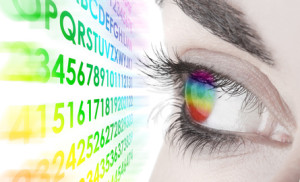It wasn’t so long ago that the very existence of synesthesia was questioned. (You may recall from an earlier post that there are 60+ types of synesthesia, the condition in which stimulation of one sense leads to automatic experience of a second sense.) Many scientists throughout the twentieth century scoffed at the idea of synesthesia – saying that people who claimed to have it just had strong childhood memories linking two senses – for example, colors and numbers.

But research during the 1980s and 90s definitively proved the existence of synesthesia, and scientists are now looking at its advantages and disadvantages. Does having synesthesia give you cognitive benefits? Does it improve memory? Is it embedded in our genes, or do we learn it through environmental associations from childhood? Can adults be taught synesthesia?
Two recent articles address these questions, as well as others. They are both open access, so if you want more than my brief sketch, you can read the articles in their entirety.
The earlier study, from November 2014, was published in Scientific Reports from the Nature Publishing Group. Scientists at the University of Sussex devised a 9-week training program to see if adult participants would be able to develop strong letter-color associations. They discovered that the participants were able to develop letter-color associations that were strong enough to pass all of the standard tests for synesthesia. And in a stunning surprise, the IQ of the participants jumped by an average of 12 points compared to controls.
The authors of the study don’t claim to have created genuine synesthetes – the effect wore off after about three months – which leads one to wonder if a low level of training continued, like practice, if the synesthesia would remain. But they say that these findings may eventually lead to training tools that would help children with ADHD, or adults beginning to suffer from dementia.
The second article was just published in the February issue of The Psychologist, an online publication of The British Psychological Society. After giving a brief history of synesthesia, writer Jack Dutton writes about synesthesia and memory, synesthesia and touch, teaching synesthesia, and synesthesia and music (teaser: Dutton suggests that if scientists are able to figure out how to teach chromesthesia, which is sound to color synesthesia, it may enhance an individual’s ability to learn to read and compose music). He also discusses the implications for treating multisensory disorders such as autism, dyslexia, and ADHD.
Happy reading!!
2 responses to “Can synesthesia be taught?”
Love stuff about synethesia! Quite a few years ago (the original system was available on cassette tapes) David Burge created a system of teaching pitch recognition which he called color hearing. He used it to teach music students in aural theory classes. They could connect pitches with whatever colors came to mind upon hearing the pitch. He also found it helpful to pair students with the same instrument – piano to piano, violin to violin – when working on this system as their ears were attuned to similar overtone qualities.
I’m seeing more aural theory courses being computerized, which means that the overtone qualities are not so much like acoustic instruments. I don’t know that students would connect colors to electronic sounds in the way they do to acoustic sounds.
Thanks, Kay. In case some people aren’t aware, the David Burge who created the system for pitch recognition is not the David Burge, pianist. Anyway, I never looked at the Burge system, so it’s interesting that he used colors. Researchers have found that some people have absolute pitch for the instrument that play, and not for others, so it would have made sense to pair students with their own instrument. I think you’re right about the problem with connecting colors to electronic sounds. It would be interesting if someone with sound-color synesthesia would like to weigh in on that.